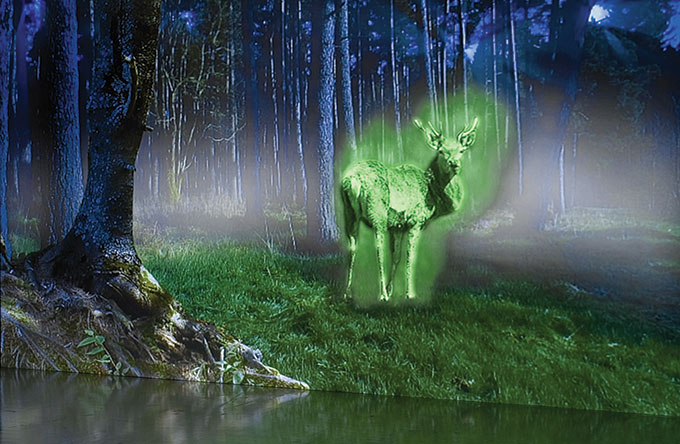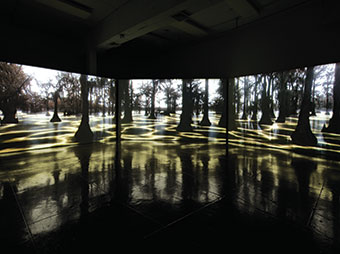Leviathan
by Jack Foran


Kelly Richardson’s exhibit at the Albright-Knox Art Gallery
Video artist Kelly Richardson’s works currently on display at the Albright-Knox Art Gallery are huge, lush, passing strange amalgams of art and nature that question both of these terms, these categories.
A work that was previously seen at the gallery but remains mysterious as ever is called Twilight Avenger. A rather ordinary-looking night forest scene loses its ordinariness when a luminous—as if radioactive—stag passes through it. In an explanatory note on the work, the artist talks about how in our current media-saturated culture “truth is difficult, if not impossible, to locate…the line between fantasy and reality becomes further and further obscured. In response to that, over the past few years I have been combining real and constructed elements, focusing on creating photographs and video installations that reflect that confusion…”
Another work is a telephoto lens shot of a dancing full moon, as perceived through the fitful medium of rising heat waves from a crackling campfire. Nature affects technology as well as technology affects nature.
Another woodsy scenario work is informed by such disparate art historical influences as 19th-century presentations of the sublime and teen summer camp setting B movies building tension in preparation for the appearance of the disfigured neighbor man ax-murderer. A night view outward through a cabin screen door besieged by a small squadron of flying insects, looking onto a tranquil—maybe too tranquil—moonlit mountain lake in the near distance.
From B movies to the B literary sub-genre science fiction as source material, but retaining the grandeur and magnificence of the visual sublime, the largest work in the show—about 10 feet high by about 60 feet long—is a planet Mars landscape, as imagined it might appear some 200 years hence. Spectacular terrain close on and in the hilly distance, but strewn with space exploration junk, including one rover-type vehicle hung up on a rock, just about out of power, feebly still attempting to manipulate its crane and bucket main explorer appendage, in vain. Like some wounded insect in its death throes. The space junk—the rover and other hardware and some half-completed constructions—remnants of a grandiose enterprise that maybe ultimately proved too costly to a home base planet out of fossil fuel and contending with the more pressing problem of oceans threatening to inundate the dry land. Or maybe we just lost interest. But of course left a mess.
An explanatory note on the piece, which is from 2012, says it “marks Richardson’s liberation from her past practices. The Sublime she once sought in the landscape is now created, pixel by pixel, by her own hand using scenery-generating software most often associated with the film and interactive gaming industries.”
Another grand-scale piece, from 2011, is a swamp scene with shadowy, rippling waters and a network of snaky light effects around the bulbous root structures of the mangrove-like trees hung with mosses. The piece is called Leviathan, and we’re told it was videographed at a lake in Texas that was the site of the first underwater drilling for oil. The snaky light effects could be the leviathan, the monster, that is somehow also oil slick. The leviathan of Biblical reference, from the Book of Job, but also political scientist/philosopher Thomas Hobbes’s Leviathan. The monster that is us. Humankind.
But which, as Hobbes teaches, must grow beyond the state of monsterhood, that is, a state of nature, to a state of society, via a social contract through which we surrender our individual selfish impulses for the good of the commonweal, the whole. Precisely what we don’t do in the environmental exploitations resulting in environmental devastations from Exxon’s in the Arctic to BP’s in the Gulf of Mexico. (And so on to Mars, Richardson says, if we last another 200 years.)
Another piece presents an apocalyptic vision of a shower of burning meteorites or spent shooting stars dropping peacefully, like snowflakes, into a still mountain lake—that mountain lake again—at night.
Another features ghostly pine trees that sway violently in gusty winds and magically disappear and reappear, in a kind of deliberately fictional badlands landscape, under a starry night sky. I’m still trying to figure out what this one is all about. The title, The Erudition, doesn’t seem to help.
The Kelly Richardson exhibit continues through June 9.
blog comments powered by Disqus|
Issue Navigation> Issue Index > v12n10 (Week of Thursday, March 7) > Leviathan This Week's Issue • Artvoice Daily • Artvoice TV • Events Calendar • Classifieds |









 Current Issue
Current Issue